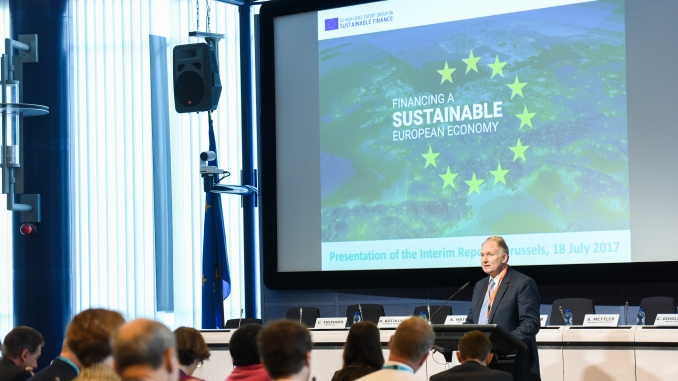
The EU High-Level Expert Group (HLEG) on sustainable finance delivered a “manifesto for far-reaching change” in the form of its final recommendations to the European Commission today (Wednesday), with a call for an official EU Green Bond Standard to be introduced this year.
The report will form the basis for an action plan on sustainable finance to be proposed by the Commission in the coming weeks.
“The EU is already at the forefront of investing in resource efficiency and social infrastructure, not least through the European Fund for Strategic Investments and its reinforced focus on climate action,” said Jyrki Katainen, Commission vice-president responsible for jobs, growth, investment and competitiveness. “At the same time, creating an enabling framework for private investors is crucial to achieving the transition to a cleaner, more resource-efficient, circular economy.
“The HLEG’s final report provides us with a roadmap to do just that and we welcome their invaluable contribution to this very important issue.”
In a foreword to the report, Katainen and Valdis Dombrovskis, vice-president responsible for financial stability, financial services and Capital Markets Union (CMU) called it a “manifesto for far-reaching change”.
Key among a raft of recommendations deemed priorities is a roadmap to developing a fully-fledged sustainability taxonomy by 2020. This is envisaged as providing the basis for various measures, including an EU Green Bond Standard, to be followed by a Green Bond label.
“As a first step towards establishing official EU sustainability standards, the EU should introduce an official EU Green Bond Standard (EU GBS),” says the report. “As a second step, it should consider an EU Green Bond label to help the market develop fully and maximise its capacity to finance green projects and activities and to contribute to wider sustainability objectives.”
The HLEG defines an EU Green Bond as any type of listed bond instrument meeting all of the following requirements (in the report’s words):
- The proceeds will be exclusively used to finance or refinance in part or in full new and/or existing eligible green projects, in line with the future EU Sustainability Taxonomy
- The issuance documentation of the bond shall confirm the intended alignment of the EU Green Bond with the EU Green Bond Standard
- The alignment of the bond with the EU Green Bond Standard has been verified by an independent and accredited external reviewer.
An issuer would only be able to use the term EU Green Bond if all three criteria are met. The HLEG says the objective of the proposed EU Green Bond Standard is to create a standard that can serve as reference for other sustainable financial products such as social and sustainable bonds, as well as green, social and sustainable loans.
“The proposed EU GBS would incorporate existing best market practice while at the same time addressing uncertainties and areas of concern that may require greater prescription or more explicit criteria,” it said.
“The prime objective of the standard is to help raise overall investments in green projects and activities, and its success should be monitored and assessed against this benchmark.”
It lists as areas of concern: uncertainty on the application of some best practices; confusion on green project definitions; doubts about additionality and green-washing; insufficient disclosure on how green bonds help scale up green activities; and inconsistencies in external reviews.
Ahead of the report and the anticipated Commission action plan, some market participants – while encouraged by the overall initiative – have raised concerns that minimum standards could restrict the market’s development and innovation.
The International Capital Market Association (ICMA) – which runs the Green Bond Principles and whose senior director Nicholas Pfaff (pictured below) was an HLEG observer – said the proposed taxonomy would provide additional clarity and detail for issuers and investors in the green bond market, and noted the recommended standard.
 “As the report itself underlines, the challenge will be to find the right balance in implementation and to not increase the regulatory burden and complexity given the ultimate purpose is to facilitate more investment,” it added.
“As the report itself underlines, the challenge will be to find the right balance in implementation and to not increase the regulatory burden and complexity given the ultimate purpose is to facilitate more investment,” it added.
The expert group recommends the introduction of the Green Bond Standard as early as this year, following the establishment of a green bonds technical committee to work in parallel with the development of the sustainability taxonomy.
The HLEG was ambivalent on the much-discussed idea of lowering capital requirements for green lending by introducing a so-called green supporting factor – or punitive charges for “brown” exposures. While noting that it could give “a strong policy signal to re-engage the banking sector”, it acknowledged the argument that capital requirements need to remain risk-based.
“As a first step on a green supporting factor, the Commission should investigate whether there is a risk-differential justifying such a factor and, if so, how it could be implemented, considering the possible drawbacks,” says the report. “Meanwhile, other public policy measures to stimulate and support borrowers for green projects could also be considered, going beyond the various recommendations in this report, such as subsidies, taxes and public guarantees.”
The HLEG report also supports a Commission initiative towards integrating ESG factors into investors’ fiduciary duties.
“Clarifying these duties will help institutional investors and asset managers allocate capital more efficiently by taking into account ESG risks and opportunities,” said Nathan Fabian, policy and research director at the PRI (Principles for Responsible Investment), who was an HLEG observer.
Proponents of green finance have been encouraged by the whole HLEG exercise and were positive about take-up of the recommendations, with one noting that the Commission had already acted on elements of the group’s interim report.
“The HLEG initiative from the Commission has been an incredible success and has been much more broadly applauded and welcomed than anticipated,” said HLEG member Sean Kidney, CEO of the Climate Bonds Initiative, which runs the Climate Bonds Standard and certification scheme. “The range of recommendations and proposals can make a substantial difference in ensuring the financial system supports the achievement of sustainability goals and environmental action.
“These recommendations provide new foundations for a sustainable economy and not just for Europe but also for the world.”
Main photo: HLEG chair Christian Thimann of AXA, copyright: EU; Nicholas Pfaff photo source: ICMA



